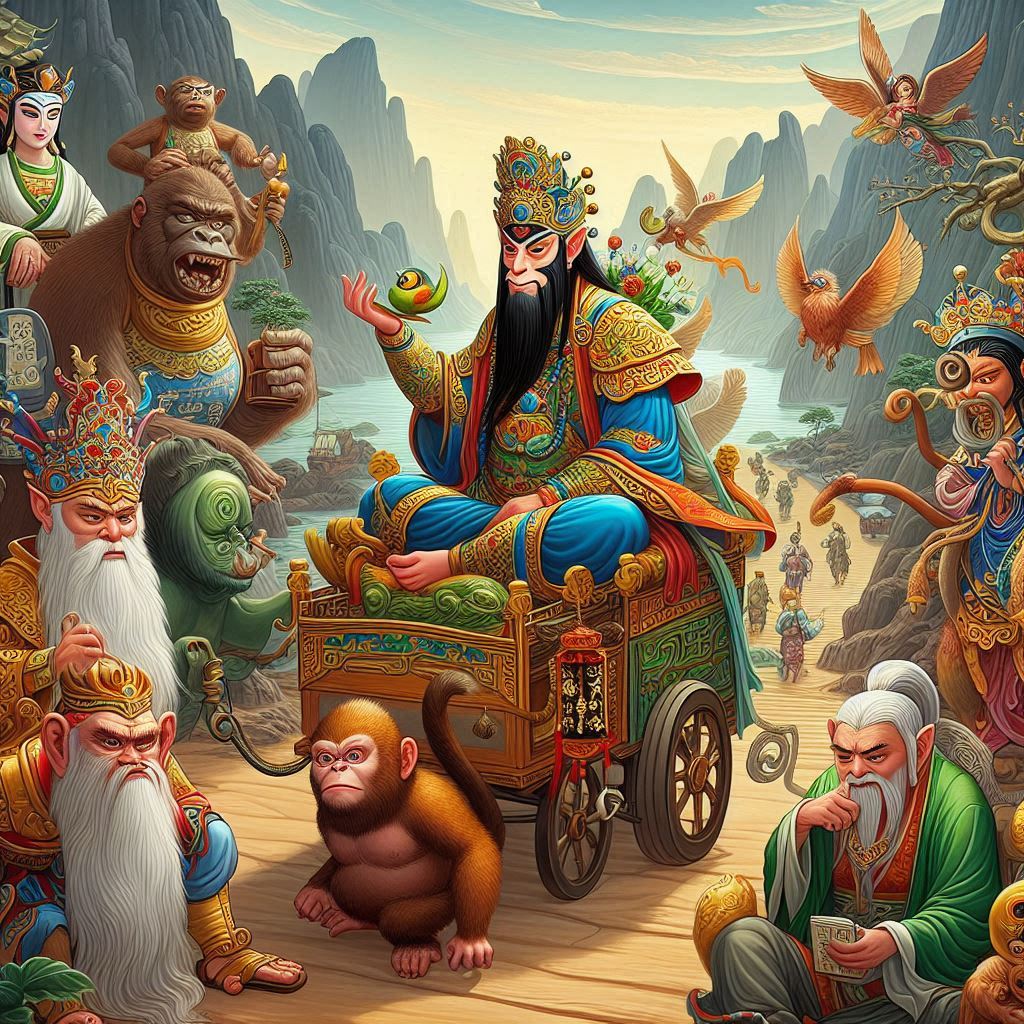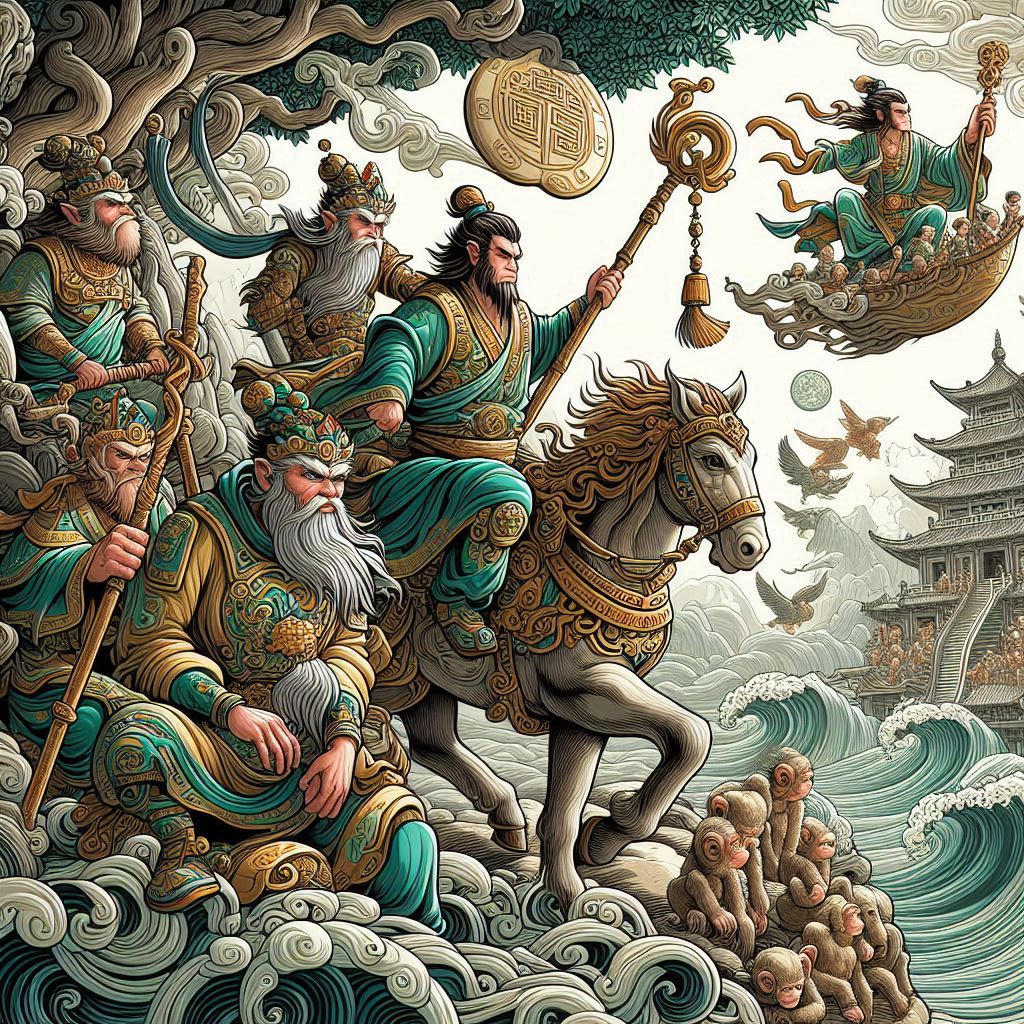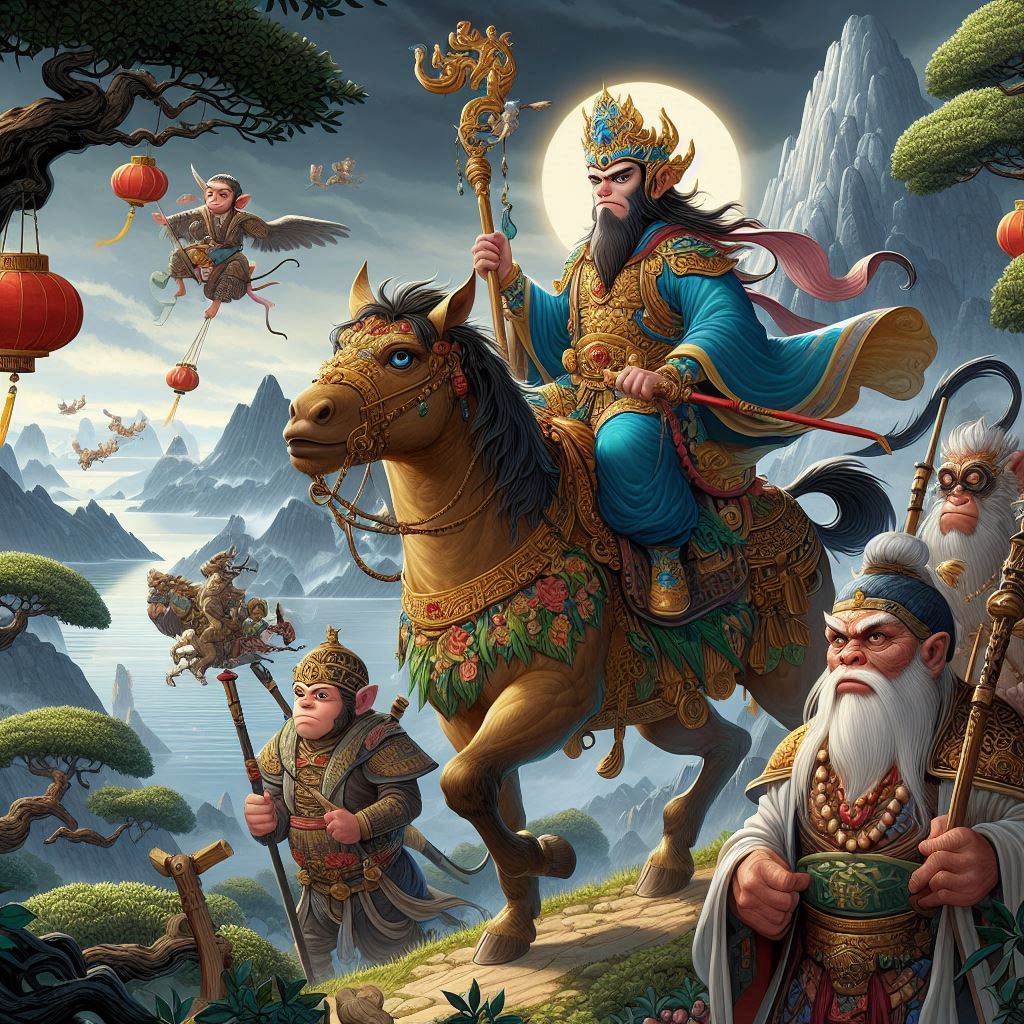《黑神話:悟空》的熱賣引發外國玩家對《西遊記》故事的研究
《西遊記》是中國四大古典名著之一,由明代小說家吳承恩編撰而成,成書於16世紀。以其獨特的奇幻色彩和豐富的神話世界深受中國文學愛好者喜愛,並被譽為中國古代文學的巔峰之一。以唐僧取經的傳說為藍本,融合民間傳說、宗教文化和神話元素,展現豐富的想像力和對當時社會的影射。
主要劇情講述唐朝僧人唐三藏(即玄奘)奉命前往西天取經,歷經九九八十一難,最終取得真經的故事。他身邊有三位忠誠的徒弟護送他前行,他們分別是:法力無邊的孫悟空、憨厚老實的豬八戒,以及忠誠勤勞的沙僧。故事中的核心情節圍繞著他們一行人遭遇各種妖魔鬼怪,經過重重考驗,最終修成正果。
主角孫悟空是《西遊記》最著名的角色之一,他是從仙石中孕育而出的猴王,生性桀驁不馴,法力高強。孫悟空曾大鬧天宮,後被如來佛祖壓在五指山下,直到唐僧將其救出並收為徒弟。孫悟空的形象集力量、勇氣和智慧於一身,在菩提老祖的指點下,通過修煉獲得七十二變化,用金箍棒跟觔斗雲來降妖伏魔,成為護送唐僧取經的關鍵人物。
豬八戒是另一個重要角色,原本是天庭的天蓬元帥,因犯錯被貶下凡間,變成一個半人半豬的形象。他貪吃好色,但心地善良,儘管經常鬧出笑話,但仍然在取經路上忠誠地跟隨唐僧。沙僧原本是天庭的卷簾大將,因打破天宮的琉璃盞被貶下界,他在取經路上負責挑擔,忠誠可靠。
《西遊記》中的妖怪角色種類繁多,代表中國神話中的各種妖魔鬼怪。這些妖怪經常擁有強大的法力,試圖攔截或吞食唐僧,以求長生不老。其中較為著名的妖怪有白骨精、紅孩兒、金角大王和銀角大王等。白骨精三次變幻形態,想要騙取唐僧的性命,最終被孫悟空火眼金睛識破並消滅。紅孩兒則是牛魔王之子,擁有強大的火焰法術,最終被觀音菩薩收服。金角和銀角大王則是太上老君的守爐童子,因偷下凡間作亂而被孫悟空制服。
這部文學對後世的影響極為深遠。首先,它塑造中國文學中許多經典的角色形象,特別是孫悟空成為中國乃至全球文化中的知名人物。他的形象充滿反叛精神與正義感,成為勇敢抗爭與智慧的象徵,激發後世無數文學作品、電影、戲劇和動畫的創作靈感。此外,小說中的取經故事被視為一種精神修行的象徵,反映佛教、道教和儒家思想的交融。唐僧師徒四人的取經過程,不僅僅是肉體上的旅程,更是一種精神上的修煉與升華。這種修行之路在後世的文學作品中被多次引用和模仿,成為一個重要的文化符號。
《西遊記》還對中國戲劇、京劇等表演藝術產生重大影響。孫悟空的形象經常出現在中國的戲曲舞台上,成為廣大觀眾喜愛的角色。此外,這部小說也影響日本、韓國等東亞國家的文化,在國際文學和影視作品中經常可以看到取經故事的改編與重現,而聞名世界的動漫《七龍珠》,故事初期的劇情就是以《西遊記》為設定。
總的來說,《西遊記》不僅是中國古代文學的瑰寶,也成為全球範圍內流傳廣泛的經典作品。它豐富的故事情節、鮮活的角色塑造、深刻的文化內涵,使得這部小說在數個世紀後依然對文學、戲劇和影視產生著重要影響。而在近期熱賣的中國首款3D遊戲《黑神話:悟空》推波助瀾下,許多外國玩家也開始研究《西遊記》的故事。
"Journey to the West" is one of China's four great classical novels, written by Ming dynasty novelist Wu Cheng'en in the 16th century. It is widely loved by Chinese literature enthusiasts for its unique blend of fantasy and mythology, and is regarded as one of the pinnacles of ancient Chinese literature. The novel is based on the legendary pilgrimage of the monk Tang Sanzang (Xuanzang) to retrieve Buddhist scriptures from the West, and it weaves together folklore, religious culture, and mythological elements, displaying rich imagination and social commentary.
The central plot revolves around the Tang dynasty monk Tang Sanzang, who is tasked with journeying to the West to obtain sacred scriptures. Alongside him are three loyal disciples who protect him on his journey: the immensely powerful Sun Wukong, the good-natured but comical Zhu Bajie, and the steadfast Sha Wujing. The core of the story focuses on their encounters with various demons and monsters, overcoming numerous challenges to eventually attain enlightenment and success in their mission.
Sun Wukong, one of the most famous characters from "Journey to the West," is a monkey born from a stone imbued with celestial energy. Rebellious by nature and extraordinarily powerful, Sun Wukong once wreaked havoc in Heaven but was eventually subdued by the Buddha and imprisoned under a mountain. He was later freed by Tang Sanzang and became his disciple. Sun Wukong embodies strength, courage, and wisdom. Guided by the sage Bodhi, he mastered the art of 72 transformations, wielded the magical staff, the Ruyi Jingu Bang, and rode the somersault cloud to subdue demons and protect his master on their journey.
Zhu Bajie, another key character, was once the Marshal Tianpeng in Heaven but was banished to Earth for his misdeeds, taking on a half-man, half-pig form. Although gluttonous and lecherous, Zhu Bajie is kind-hearted and remains loyal to Tang Sanzang, despite often providing comic relief along the way. Sha Wujing, once a general in Heaven, was punished and sent to Earth for breaking a celestial vase. On their journey, he carries the luggage and remains dependable and devoted to his master.
The novel features a wide array of demons and monsters, representing various supernatural beings in Chinese mythology. These creatures often possess great powers and seek to capture or devour Tang Sanzang to gain immortality. Among the most notable are the White Bone Demon, Red Boy, and the Gold and Silver Horned Kings. The White Bone Demon attempts to deceive Tang Sanzang three times, only to be seen through and defeated by Sun Wukong's sharp eyes. Red Boy, the powerful fire-wielding son of the Bull Demon King, is eventually subdued by the bodhisattva Guanyin. The Gold and Silver Horned Kings, attendants of the Supreme Lord Laozi, descend to Earth and cause havoc before being captured by Sun Wukong.
The impact of "Journey to the West" on subsequent generations is profound. Firstly, it has created some of the most iconic characters in Chinese literature, especially Sun Wukong, who has become a legendary figure in both Chinese and global culture. Sun Wukong’s rebellious spirit and sense of justice symbolize bravery and intelligence, inspiring countless literary works, films, theatrical performances, and animated series.
Moreover, the pilgrimage story has come to symbolize a spiritual journey, reflecting the synthesis of Buddhist, Daoist, and Confucian ideals. The journey undertaken by Tang Sanzang and his disciples is not merely a physical one but also a process of spiritual cultivation and transcendence. This notion of spiritual growth has been referenced and adapted in numerous later literary works, becoming an important cultural motif.
"Journey to the West" has also greatly influenced Chinese opera, Peking opera, and other performing arts. Sun Wukong is a recurring character on the Chinese theatrical stage, beloved by audiences for his lively persona. The novel’s influence extends beyond China, shaping the cultures of other East Asian countries such as Japan and Korea. In international literature and cinema, the pilgrimage story is frequently adapted and reinterpreted. The globally popular anime Dragon Ball draws its early plot inspiration from Journey to the West, with its characters and settings echoing those of the novel.
In summary, Journey to the West is not only a treasured gem of ancient Chinese literature but has also become a globally renowned classic. Its intricate plot, vivid characters, and deep cultural significance have continued to shape literature, theater, and film for centuries. Recently, with the success of the Chinese 3D video game Black Myth: Wukong, many foreign players have shown an increased interest in exploring the story of Journey to the West.



照片:DALLE3
- 1
- 2
- 3
- 4
